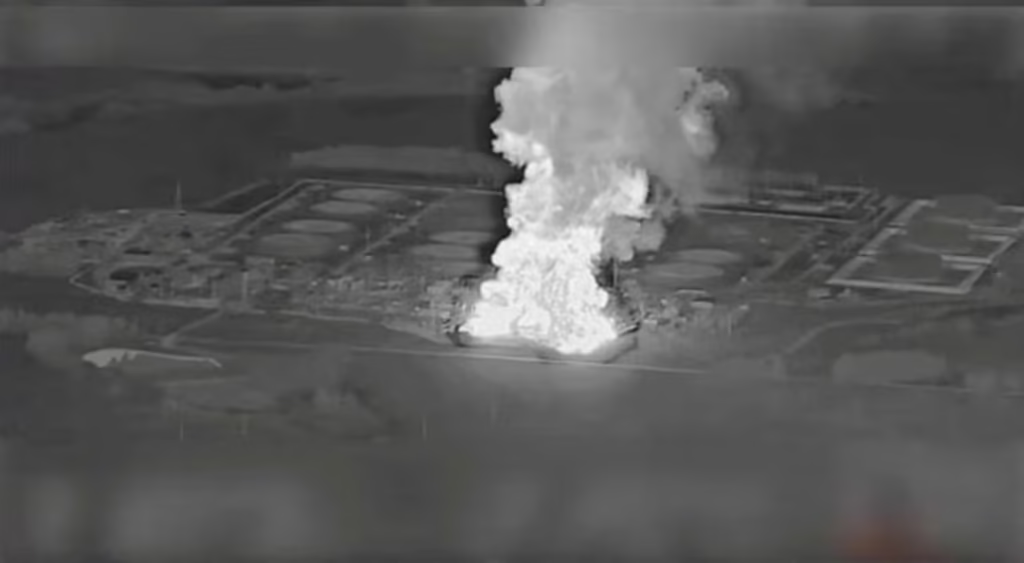MOSCOW — (Reuters) – Ukraine has stepped up drone attacks on Russian oil refineries and exporting infrastructure, striking the most important sector of President Vladimir Putin’s economy to show it can fight back as the United States seeks to broker a peace deal.
The attacks disrupted Moscow’s oil processing and exports, created gasoline shortages in some parts of Russia and came in response to Moscow’s advances on the front lines and its pounding of Ukraine’s gas and power facilities.
Kyiv’s move is an attempt to raise the stakes in possible peace talks and challenge the idea that Ukraine has already lost the war after U.S. President Donald Trump and Putin met in Alaska this month, analysts have said.

Ukrainian attacks on 10 plants disrupted at least 17% of Russia’s refinery capacity, or 1.1 million barrels per day, according to Reuters calculations.
The drone war has pushed more crude towards exports from the world’s No.2 oil exporter at a time Washington is pressing China and India to reduce purchases of Russian oil.
The refinery hits come as Russia’s seasonal demand for gasoline from tourists and farmers peaks.
Kyiv’s move is an attempt to raise the stakes in possible peace talks and challenge the idea that Ukraine has already lost the war after U.S. President Donald Trump and Putin met in Alaska this month, analysts have said.
Ukrainian attacks on 10 plants disrupted at least 17% of Russia’s refinery capacity, or 1.1 million barrels per day, according to Reuters calculations.
The drone war has pushed more crude towards exports from the world’s No.2 oil exporter at a time Washington is pressing China and India to reduce purchases of Russian oil.
The refinery hits come as Russia’s seasonal demand for gasoline from tourists and farmers peaks.
Russia relies on oil and gas exports for a quarter of its budget revenues, which are funding a 25% rise in defence spending this year to the highest levels since the Cold War.
Western sanctions have forced Moscow to sell oil at discounts and stop gas sales in most of Europe. This has not deterred Moscow from producing record numbers of artillery and weapons, according to U.S. military generals.
The war in Ukraine has become a battle of attrition with both Russia and Ukraine using drones and missiles to strike far behind the front lines to damage each other’s economies.
So far, Russia’s economy has coped with the sanctions but growth has slowed raising concern in the Kremlin.
In the past month, Ukraine has attacked Lukoil’s Volgograd, Rosneft’s Ryazan and a host of other plants in the Rostov, Samara, Saratov and Krasnodar regions.
A fire at Russia’s Novoshakhtinsk refinery was still burning on Monday after a Ukrainian drone strike.
Ukrainian drones also attacked the Druzhba pipeline and Novatek’s (NVTK.MM), opens new tab Ust-Luga export terminal and fuel processing complex on the Baltic.
Ukrainian drone attacks on Russian oil refineries and export infrastructure have disrupted Russia’s refining and export operations, triggered gasoline shortages in some regions, and served as a response to Moscow’s strikes on Ukraine’s gas and energy facilities.
Reuters reported this, as cited by Ukrinform.
According to Reuters calculations, Ukrainian attacks on 10 plants have disrupted at least 17% of Russia’s refinery capacity, or 1.1 million barrels per day. The refinery strikes came during peak seasonal demand for gasoline from tourists and farmers. Even before the attacks, Russia tightened its gasoline export ban in July to cope with soaring domestic demand.
Some areas in temporarily occupied Ukrainian territories, southern Russia, and the Far East experienced shortages of gasoline, forcing motorists to switch to more expensive fuel as regular A-95 became scarce.
Over the past month, Ukraine has attacked the Lukoil refinery in Volgograd, the Rosneft refinery in Ryazan, and several others in Rostov, Samara, Saratov, and Krasnodar regions. A fire at Russia’s Novoshakhtinsk refinery was still burning on Monday after a Ukrainian drone strike. Ukrainian drones have also attacked the Druzhba pipeline, the Novatek export terminal in Ust-Luga, and a fuel-processing complex on the Baltic Sea.
According to Sergey Vakulenko, a senior fellow at the Carnegie Russia Eurasia Center, who previously worked at Russian oil major Gazprom Neft, the damaged refineries have only lost part of their capacity, but even that could cause problems with domestic fuel supplies.Read also: Ukraine strikes Syzran oil refinery in Russia, General Staff confirms
Russia relies heavily on oil and gas exports, which provide about a quarter of its budget revenues — funding a 25% increase in defense spending in 2025.
“Western sanctions have forced Moscow to sell oil at discounts and stop gas sales in most of Europe. This has not deterred Moscow from producing record numbers of artillery and weapons, according to U.S. military generals. The war in Ukraine has become a battle of attrition with both Russia and Ukraine using drones and missiles to strike far behind the front lines to damage each other’s economies. So far, Russia’s economy has coped with the sanctions but growth has slowed raising concern in the Kremlin,” Reuters noted.
As reported earlier, sales of AI-92 gasoline to the public were suspended in Russia’s Kuril Islands, part of Sakhalin region.
Reporting by Reuters in Moscow; Writing by Guy Faulconbridge; Editing by Sharon Singleton
Our Standards: The Thomson Reuters Trust Principles
SOURCE: Reuters and Ukrinform



